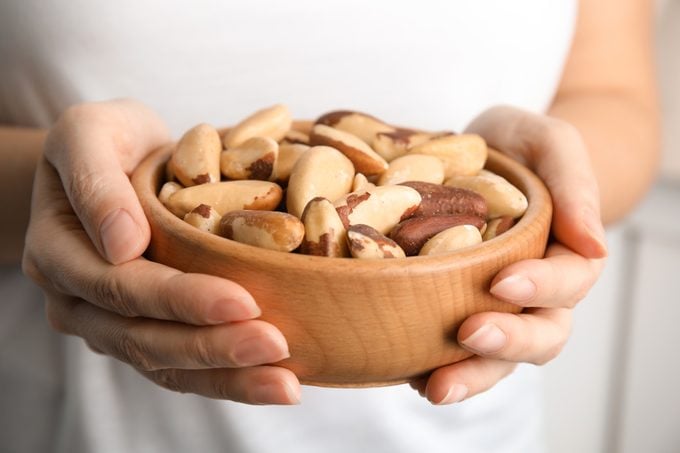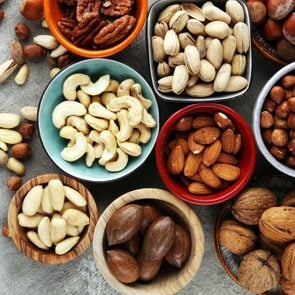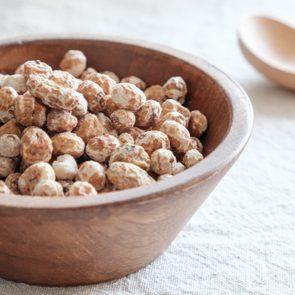Are Brazil Nuts Good for You? Here’s What Nutritionists Say
Updated: Mar. 17, 2022
Brazil nuts are nutrient-packed nuts grown from enormous trees in the Amazon. Here's what you need to know about their nutrition, calories, risks, benefits, and how to eat them.
Brazil nuts—not just a member of the cocktail mix
You’re likely used to seeing a few Brazil nuts as part of a salty and tasty cocktail mix. And although they haven’t gotten as much attention as walnuts or pecans, that’s changing. Lately, Brazil nuts are showing up in all kinds of foods and drinks. Brazil nuts‘ newfound fame points to the surging popularity of vegan and keto diets, according to a 2019 report by Technavio, a market research company.
Like all tree nuts—such as almonds, cashews, hazelnuts, pecans, walnuts, and pistachios—Brazil nuts are little wonders packed with nutrient-dense goodness.
“Brazil nuts are similar to other tree nuts in that they contain plant-based protein, healthy unsaturated fats, fiber, vitamins, minerals, and phytochemicals,” says Nichole Dandrea, RD, a registered dietitian in Santa Ana, California. But one of the main reasons for the Brazil nut’s nutrition claim to fame is its selenium—a powerful mineral and antioxidant.
Here’s what you need to know about Brazil nuts nutrition, benefits, risks, and how to properly prepare and store them.
How Brazil nuts are grown
Despite its name, the Brazil nut is actually a seed.
“By definition, nuts are ‘hard-shelled fruits’ that contain a single, large seed, like the pistachio or walnut,” says Deborah Malkoff-Cohen, RD, a New York City-based registered dietitian. Brazil nuts are harvested from Brazil nut trees, which grow to staggering heights (160 feet or even taller).
They’re predominantly found in the Amazon rainforest in Brazil, Bolivia, Colombia, Venezuela, Ecuador, and Peru. The seeds have eight to 24 clusters inside a hard shell that resemble the segments of an orange.
Each seed ranges in size from a baseball to a coconut, weighing about five pounds. You don’t want to get caught under a seed when it ripens and falls to the ground. Descending at 50 miles an hour, you could be in for a whopper of a headache.
And even if the seed hit your head, the rock-solid shell wouldn’t break and scatter. You will need a nutcracker to get to the creamy nut inside—unless you’re pals with the well-known Brazil nutcracker, the agouti, a large rodent with chisel-like teeth.
Brazil nuts nutrition
Brazil nuts top the charts for one mineral—selenium. Selenium is essential for metabolism and thyroid function, yet we need only need a small amount daily.
One Brazil nut contains around 68 to 91 micrograms of selenium, says Malkoff-Cohen. The recommended daily allowance (RDA)—the estimated amount of nutrient necessary per day—for adults is 55 micrograms.
“Each Brazil nut contains 175 percent of the RDA for selenium,” says Dandrea-Russert. The amount of selenium varies depending on the soil and the water that the trees are grown in. The substantial amount of selenium in Brazil nuts means it outshines the other tree nuts in this department. Most other nuts contain only one microgram of selenium.
Given that Brazil nuts are selenium all-stars, you don’t need to eat too many. “The maximum amount of Brazil nuts you should eat per day is three or you could be headed for selenium toxicity as the upper limit is 400 micrograms daily,” says Malkoff-Cohen.
Especially if you factor in other selenium-rich foods you may be eating like fish, chicken, eggs, and enriched pasta and bread; not to mention a daily vitamin.

Notable nutrients in just one Brazil nut
Given that you shouldn’t eat Brazil nuts by the handful, here are the notable nutrients in one Brazil nut (5 grams) and the daily value (DV) of certain nutrients based on a 2,000-calorie diet.
Calories: 33
Fiber: 0.4 g (1 percent DV)
Protein: 0.7 g (1 percent DV)
Fats: 3.4 g (4 percent DV)
Carbohydrates: 0.6 g (0 percent DV)
Symptoms of chronic and acute intake of Brazil nuts
It’s not just excessive handfuls of Brazil nuts that you should avoid. Remember, selenium is in other foods and multivitamins. Eating past the upper limit of 400 micrograms daily, whether it is Brazil nuts or other foods, can make you sick.
Some early signs you’ve had too much selenium: You have garlic breath and a metallic taste in your mouth. More commonly, hair loss and nail loss or brittleness can occur. Other signs of persistent selenium overload are nausea, diarrhea, skin rashes, fatigue, irritability, nervous system abnormalities, and mottled teeth.
Consuming a large amount of Brazil nuts or supplements with too much selenium can have serious health implications.
Symptoms include lightheadedness, facial flushing, acute respiratory distress syndrome, severe gastrointestinal issues, tremors, lightheadedness, facial flushing, myocardial infarction, neurological symptoms, kidney failure, cardiac failure, and—in rare cases—death.
Also, those who have existing nut allergies shouldn’t eat Brazil nuts. It’s important to note that tree nut allergies—and other food allergies—can develop later in life.
Seek medical attention immediately, if you experience the symptoms above, or develop symptoms of an allergic reaction, which can include wheezing; coughing; hives; an itchy mouth; face, lip, or throat swelling; and dizziness.
Potential benefits of Brazil nuts
Lower total cholesterol
Similar to other tree nuts, due to their healthy fatty acid composition, antioxidants, and fiber content, Brazil nuts have been shown to help lower total cholesterol,
LDL cholesterol, and triglycerides, says Dandrea-Russert. Plus, polyunsaturated fats are good for your heart. (Here’s how to spot selenium deficiency symptoms.)
Help keep you full longer
“Due to their fiber content (two grams per ounce), protein content, and healthy polyunsaturated fats, they can help with satiety, keeping you full longer, which may help with weight loss,” says Dandrea-Russert.
Be sure to put these foods loaded with healthy fats on your grocery list.
Selenium for fertility
“Any individual who is even thinking of hopping on the parent train should ensure their selenium needs are met,” says Malkoff-Cohen. But there’s not a specific blood test to see if you’re hitting the selenium mark. Instead, your doctor can measure your levels of glutathione peroxidase, “an enzyme that is required for selenium to function,” she adds.
“If levels are low, you may not have enough selenium. Low levels of selenium can contribute to miscarriage, low semen quality, and poor sperm motility,” says Malkoff-Cohen. “And new research shows that selenium may also help maintain the health of follicular fluid surrounding women’s eggs. I see Brazil nut butter and jelly sandwiches becoming very popular.”
Thyroid health
Your thyroid gland plays a significant role in your body. It is responsible for producing hormones that regulate metabolism, body temperature, and is necessary for growth. The thyroid organ depends on selenium to function properly.
“Just one Brazil nut contains enough selenium to produce adequate thyroid hormones and the proteins needed to protect your thyroid,” says Malkoff-Cohen.
Getting adequate amounts of selenium is especially important if you have existing issues with your thyroid and you consume lots of raw cruciferous veggies, such as Bok choy, broccoli, Brussels sprouts, and cauliflower.
Why? Cruciferous veggies contain goitrogens, a naturally-occurring chemical that meddles with thyroid function, says Malkoff-Cohen.
For people with thyroid issues, a high intake of goitrogens can worsen thyroid function. But that doesn’t mean you have to stop eating your favorite cruciferous veggies. Just be sure to roast, steam, or grill them instead of eating them raw, suggests Malkoff-Cohen.
(Should you get your thyroid levels checked? Here’s what you should know first.)
May help with inflammation
Brazil nuts contain phytonutrients, “including selenium, vitamin E, and phenols like gallic acid and ellagic acid, all of which have been shown to reduce inflammation and protect your body from oxidative stress,” says Dandrea-Russert.
Oxidative stress happens inside your body and can contribute to aging by damaging DNA, cells, and proteins. And it can set the stage for the a number of health conditions, including diabetes, cancer, and Alzheimer’s.
Brazil nuts warning
Brazil nuts are a tough nut to crack. The shell is rock hard. And even with a nutcracker, it can be challenging to hold a Brazil nut securely and break it open. That’s probably why shelled Brazil nuts cost more.
If you’re inclined to buy Brazil nuts in the shell, be aware that a poisonous toxin called aflatoxin can be found on some shells, Dandrea-Russert says. Aflatoxin-producing fungi can grow on certain crops, including tree nuts.
Dandrea-Russert says the European Union has strict regulations on importing Brazilian-harvested nuts in their shells. But if you happen to come across moldy, shriveled, or discolored shells (they’re usually a deep brown), toss them. (This is what happens when you accidentally eat mold.)
Healthy ways to prepare shelled Brazil nuts
The easiest way to eat a Brazil nut a day is to pick up a ready-to-eat variety from the grocery store. Some can be coated in salt or sugar so be sure to read the label before buying.
They are sold in-shell or shelled. You can enjoy them raw or roasted. Dandrea-Russert says the key to roasting Brazil nuts (or any nut) is low heat (120-160 degrees F). Low heat equals less oxidation, keeping those harmful free radicals from rising, according to a study in Food Chemistry.
“Roasting also reduces the risk of contaminants like bacteria, not to mention it makes nuts more delicious, says Dandrea-Russert.
Soaking Brazil nuts then dehydrating them is another tasty option that also boosts their health benefit. It can lower the phytic acid levels, allowing for more of their minerals to be absorbed, and it makes the nuts easier to digest.
“Since Brazil nuts are high in healthy fats, similar to walnuts, they only need to be soaked for four hours before dehydrating,” says Dandrea-Russert. “Each dehydrator is different, but generally speaking, nuts dehydrate in 12 to 24 hours.”
How to consume Brazil nuts
You can use Brazil nut milk as a dairy alternative or sprinkle chopped Brazil nuts in breakfast bowls. Brazil nuts can be found in snack bars, as Brazil nut flour, and ground into a yummy nut butter. Here are some other suggestions from Dandrea-Russert:
- Pair a Brazil nut with a piece of good-for-you dark chocolate
- Crush Brazil nuts and add to salads and grain bowls
- Add chopped nuts to homemade pesto
- Add Brazil nuts to other nuts to make nut butter
- Toss a chopped Brazil nut into your smoothie to add a creamy and nutty flavor
How to store Brazil nuts
Since you won’t be eating handfuls of Brazil nuts daily, how can you keep them fresh for extended periods of time?
“If you purchase nuts in bulk, store half in the freezer to keep them from going rancid and keep the rest in the pantry or refrigerator for quick use,” suggests Malkoff-Cohen.
Next, here’s what you need to know about tiger nuts.






















